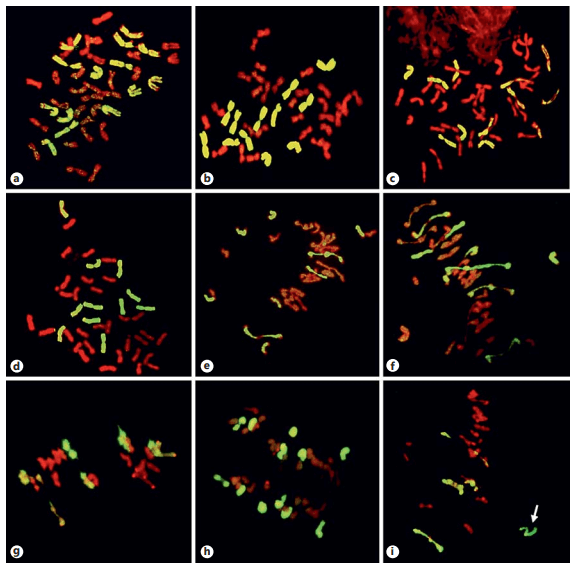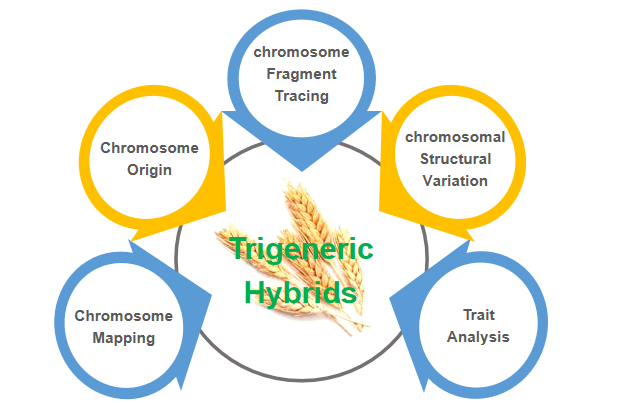Trigeneric Hybrids GISH Assay
Creative Bioarray focuses on FISH technology services and is committed to expanding the impact of FISH technology on in situ analysis of nucleic acids in biological-related research. Our probe customization service can help researchers solve situations where commercial probes cannot be found, and we can also work with researchers to develop probe sets. Our platform offers a variety of options, which gives us the confidence to provide high-quality analytical testing services to our clients.
Trigeneric Hybrids and Cytogenetic
Genetic variation in cultivated species has been greatly diminished due to the frequent use of the same parental genotypes in breeding programs. A fundamental approach to improving the yield and quality of cultivated species is to broaden their narrow genetic background. The use of polyploidy breeding and intergeneric crossbreeding are strategies to expand the genetic background, especially trigeneric crossbreeding. Taking wheat as an example, the wild relatives of wheat have excellent agronomic traits such as wide adaptability, resistance to biotic and abiotic stress, and good quality, which provide rich genetic diversity for wheat improvement. Trigeneric hybrids are usually used as bridges to transfer multiple foreign genes endowed with excellent traits into common wheat, so as to expand the genetic source of wheat breeding, enrich the genetic basis, and improve wheat yield and quality. To date, many trigeneric hybrids have been produced by crossing intergeneric hybrids or diploids with other species, or by crossing different diploids. Trigeneric hybrids are often used as bridges to transfer genes from some wild species to cultivated wheat and to measure genomic interactions between donor species.
 Fig 1. Example of GISH analysis of a trigeneric hybrid line in metaphase. (Hou-Yang Kang et al., 2016)
Fig 1. Example of GISH analysis of a trigeneric hybrid line in metaphase. (Hou-Yang Kang et al., 2016)
Availability of GISH in Crop Breeding
GISH technology can be used for dye mapping and cytogenetic analysis of trigeneric hybrids to delineate the genetic background of cultivated species. This technique helps researchers trace the source of genetic material, identify chromosomal structural variations that occur in crosses, and the location of genes of interest. GISH technology, like FGISH, has developed protocols for multicolor analysis that provide researchers with beautiful pictures of chromosomes. Our FISH technology platform is developing the potential of FISH technology and provides customers with personalized probe set design and customization services. Relying on the rich service experience of our technology platform, we provide customers with competitive probe products.
Application of GISH in Crop Breeding
- Chromosome mapping of the progeny of trigeneric hybrids
- Chromosome origin and parental chromosome fragment tracing in the offspring of trigeneric hybrids
- Gene analysis and chromosomal mapping to identify useful traits in progeny of trigeneric hybrids
- Identification of chromosomal structural variation resulting from breeding in the offspring of Trigeneric hybrids
- Chromosomal location of the gene of interest
 Fig 2. Chromosomal identification for trigeneric hybrids.
Fig 2. Chromosomal identification for trigeneric hybrids.
If you are interested in our service, please contact us for cooperation. We look forward to cooperating with you in the near future.
References
- Kang, Hou-Yang, et al. "Cytogenetic behavior of trigeneric hybrid progeny involving wheat, rye and Psathyrostachys huashanica." Cytogenetic and Genome Research 148.1 (2016): 74-82.
- Li, Jianbo, et al. "Introduction of Thinopyrum intermedium ssp. trichophorum chromosomes to wheat by trigeneric hybridization involving Triticum, Secale and Thinopyrum genera." Planta 245.6 (2017): 1121-1135.
All products and services on this website are only suitable for non-medical purposes.


 Fig 1. Example of GISH analysis of a trigeneric hybrid line in metaphase. (Hou-Yang Kang et al., 2016)
Fig 1. Example of GISH analysis of a trigeneric hybrid line in metaphase. (Hou-Yang Kang et al., 2016) Fig 2. Chromosomal identification for trigeneric hybrids.
Fig 2. Chromosomal identification for trigeneric hybrids.


